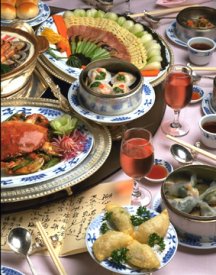Chopsticks and Pain
Chopsticks. In North America, they’re the emblem of an increasingly popular cuisine. However, few of the Westerners patronizing East Asian restaurants have mastered the art of scooping rice or tweezing meat, veggies, and noodles with a pair of bamboo rods. As a result, many people eat Chinese and other Asian entrees using cutlery. If there’s any consolation to those of us who have fumbled with chopsticks, a new study questions the ergonomics of these dining implements.

It appears that the regular, long-term use of chopsticks can foster the development of age-related arthritis.
Osteoarthritis is the degeneration of joints, primarily in elderly people. Its destruction of cartilage and ensuing damage to bone and joints causes stiffness and chronic, intense pain. Although genetics makes many people vulnerable to osteoarthritis, repetitive motions can aggravate the disease in affected joints. Indeed, where this disease affects the fingers, those on the most-used hand tend to suffer most.
Because the pinching motions associated with using chopsticks to eat and cook constitute a type of repetitive motion, an international team of researchers decided to probe the role of chopsticks in the development of osteoarthritis among 2,500 elderly Beijing residents.
Boston University rheumatologist David J. Hunter and his colleagues X-rayed the volunteers’ hands and recorded each person’s cartilage loss at the joints–a diagnostic feature of osteoarthritis–and his or her chopstick use. Questionnaires administered to the mostly 70-year-old participants surveyed handedness, pincerlike motions people regularly made independent of using chopsticks, and other potentially confounding activities, such as digging in gardens.
Hunter’s team found that roughly one-third of the volunteers were ambidextrous. However, because such people still tend to prefer the use of one hand over the other for chopstick use, the researchers were able to tease out whether the chopsticks hand suffered more damage than the other.
And it did, Hunter reported last week in Orlando at the American College of Rheumatology Annual Scientific Meeting.
Old joints
Cartilage, a pliable, slippery tissue, allows the ends of bones to glide over each other and serves as a shock absorber. Osteoarthritis erodes that cartilage. When unprotected bones at a joint rub together, pain, swelling, and stiffness can occur. Over time, the joint may become malformed, and bone spurs can emerge. When cartilage or parts of a spur break free and float around in the joint, more pain and damage can result.
By age 65, more than half of all individuals will have X-ray evidence of osteoarthritis in at least one joint. Far younger people may also suffer from this disease, often triggered by a sports injury.
In their new study, the researchers found that the joint within the thumb appeared most vulnerable to chopsticks-aggravated arthritis. In that joint, chopsticks use “accounted for about 35 percent of the risk of its developing osteoarthritis,” Hunter reports. At somewhat lesser risk were the knuckles–the joints bordering the palm–and the joints just beyond the knuckles of the index and middle fingers.
When they started the study, the researchers didn’t expect to find an association between chopsticks and osteoarthritis, Hunter recalls. Now that they have, he and his colleagues are starting an analysis of biomechanical stresses in the hand during the manipulation of chopsticks.
With that information, “our next most logical step would be trying to design more ergonomically friendly chopsticks,” Hunter says. He acknowledges that many diners in Asia might object to a Bostonian criticizing implements that their ancestors have been using for thousands of years. Hunter says he probably won’t have to take that kind of heat because “most of my coauthors are Chinese.”
What significance do the findings suggest for Western diners at Chinese and other East Asian restaurants? None, Hunter says. Any impacts on arthritis probably trace to “chronic, long-term exposure,” he says. “So, if you’re just using [chopsticks] socially, you should have nothing to be worried about.”







